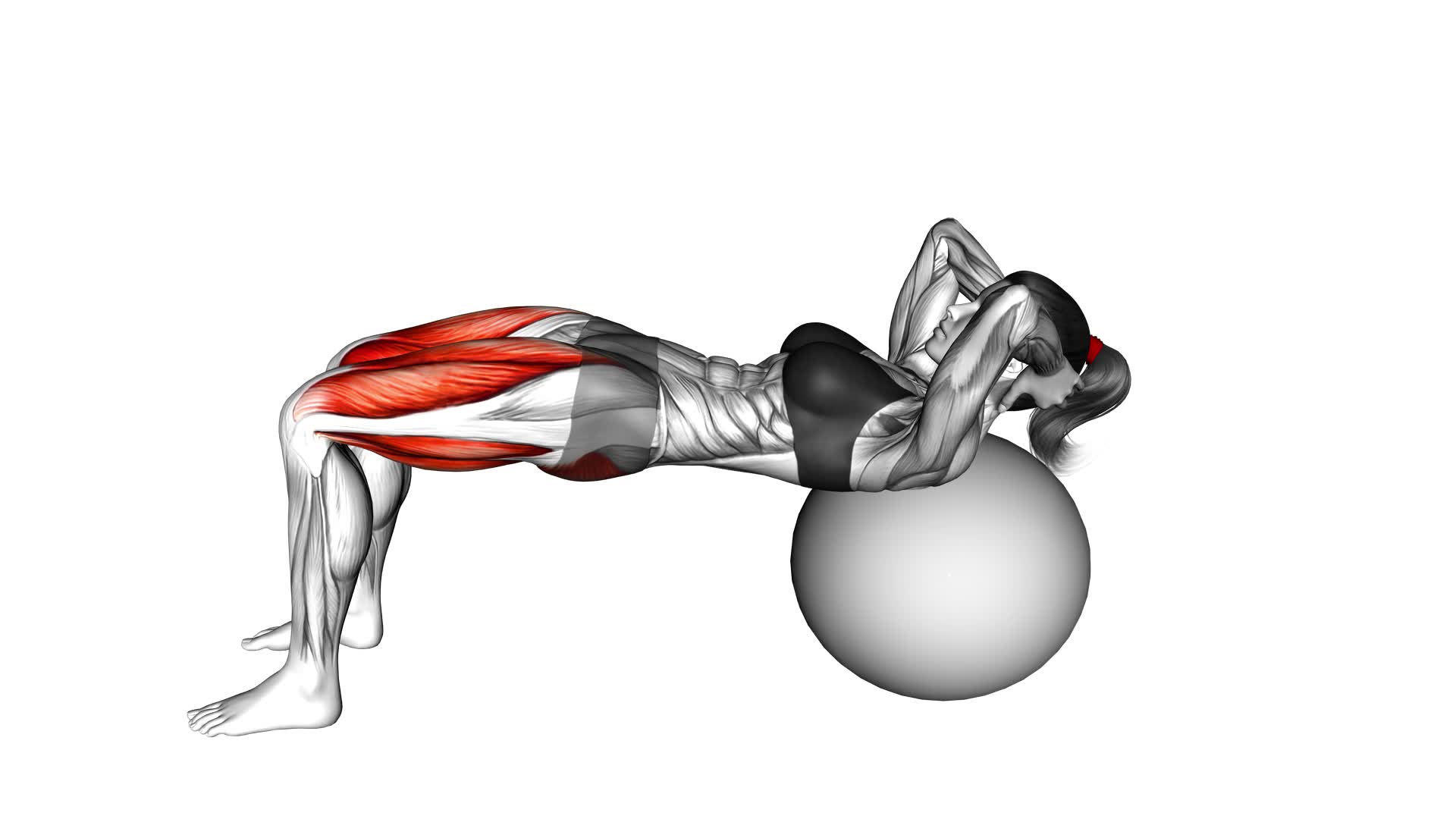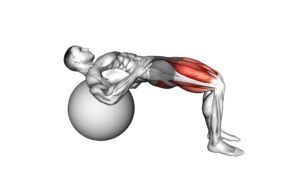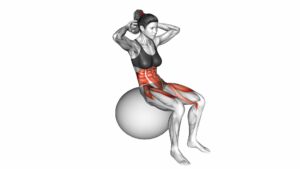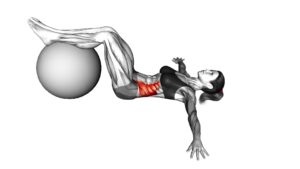Lying Hip Lift (On Stability Ball) – Video Exercise Guide & Tips

Are you looking for an effective exercise to target your hip muscles? Look no further than the lying hip lift on a stability ball.
Watch This Exercise Video
This exercise not only strengthens your hips, but also engages your core and improves stability.
In this video exercise guide, you'll learn the proper form and technique, as well as modifications for different fitness levels.
Avoid common mistakes and get the most out of your workout with these helpful tips.
Let's get started!
Key Takeaways
- The lying hip lift on a stability ball strengthens hip muscles and engages core muscles.
- This exercise improves stability and supports spine health.
- It enhances overall stability and can be done using a stability ball, a flat and stable surface, and a yoga mat or exercise mat.
- Proper form and technique are crucial, including engaging the core, maintaining proper alignment, and avoiding excessive arching or rounding of the spine.
Benefits of the Lying Hip Lift
You can experience significant improvements in core strength and stability by regularly practicing the lying hip lift exercise on a stability ball. This exercise primarily targets the muscles in your core, specifically the rectus abdominis, obliques, and transverse abdominis. By engaging these muscles, you can strengthen your core, which plays a crucial role in supporting your spine and improving overall stability.
To incorporate the lying hip lift into your workout routine, begin by lying on your back with your knees bent and your feet flat on the stability ball. Place your arms at your sides for support. Engage your core and press your lower back into the floor. From this position, exhale and lift your hips off the ground, pushing through your heels and squeezing your glutes. Hold this position for a few seconds before lowering your hips back down to the starting position.
To increase the challenge, you can try performing the exercise with one leg extended straight in the air, or by adding a resistance band around your thighs. Aim to perform 2-3 sets of 10-15 repetitions, gradually increasing the intensity as your core strength improves.
Incorporating the lying hip lift into your workout routine can help you develop a stronger core, improve stability, and prevent injuries. Remember to maintain proper form and listen to your body to avoid strain or discomfort.
Equipment Needed for the Exercise
To perform the lying hip lift exercise on a stability ball, you'll need a stability ball and a flat surface. The stability ball should be properly inflated and large enough to support your body weight. It's important to choose a stability ball that's the appropriate size for your height. To determine the correct size, sit on the ball with your feet flat on the ground and your knees at a 90-degree angle. Your hips should be level with or slightly higher than your knees.
When selecting a flat surface, make sure it's stable and secure. It could be a yoga mat, exercise mat, or a carpeted floor. Avoid performing the exercise on slippery or uneven surfaces to prevent accidents or injuries.
If you want to add more challenge or variety to your workout, there are several exercise variations you can try. For example, you can perform the lying hip lift with your feet on the stability ball and your hands on the ground for added stability. Another variation is to lift one leg off the ground while performing the exercise. This engages your core and glute muscles even more.
Remember to always warm up before attempting any exercise and consult with a healthcare professional if you have any pre-existing conditions or injuries.
Proper Form and Technique
Let's focus on the key points to ensure proper form and technique during the lying hip lift exercise.
First, engage your core by actively squeezing your abdominal muscles throughout the movement.
Secondly, position the stability ball under your feet and lower back, making sure it's stable and secure.
Lastly, pay attention to your breathing, exhaling as you lift your hips and inhaling as you lower them back down.
Mastering these points will help you perform the exercise correctly and maximize its benefits.
Core Engagement Tips
When performing the lying hip lift on a stability ball, it's essential to engage your core properly for maximum effectiveness and safety.
Core activation is crucial in this exercise as it helps stabilize your body and maintain proper alignment. To engage your core, start by drawing your belly button towards your spine, creating a slight contraction in your abdominal muscles. This will help activate your deep core muscles, such as the transverse abdominis.
Additionally, focus on maintaining a neutral spine throughout the movement, avoiding any excessive arching or rounding. By engaging your core, you won't only increase the effectiveness of the lying hip lift but also reduce the risk of injury.
Remember to prioritize proper form and technique to achieve optimal muscle engagement and reap the benefits of this exercise.
Ball Position Guide
Now, let's focus on the proper form and technique for positioning the stability ball in the lying hip lift exercise.
To begin, place the stability ball under your lower back, with your feet flat on the floor and your knees bent. Make sure the ball is positioned in a way that allows your hips to lift off the ground when you engage your glutes and core.
The ball should be stable and secure, supporting your bodyweight throughout the exercise. It's important to maintain a neutral spine and avoid excessive arching or rounding of the lower back. Remember to keep your core engaged and your movements controlled.
As you progress, you can try different variations and alternative exercises to target your glutes and core muscles from different angles.
Breathing Techniques Explained
Begin by focusing on your breathing technique during the lying hip lift exercise on the stability ball. Proper breathing is essential for maximizing the effectiveness of any exercise, including the hip lift.
When performing this exercise, take a deep breath in through your nose as you lower your hips towards the ground. As you exhale through your mouth, engage your core muscles and lift your hips back up. This breathing pattern helps stabilize your core and maintain proper form throughout the movement.
Breathing exercises not only enhance your performance but also increase oxygen flow to your muscles, aiding in their recovery and preventing fatigue. Remember, the importance of breathing can't be overstated, so make sure to prioritize it during your workouts.
Modifications for Different Fitness Levels
To modify the lying hip lift exercise on a stability ball for different fitness levels, you can adjust the level of difficulty by using a quantifier determiner. Here are three options to consider:
- Decrease Stability: For beginners or individuals with limited core strength, you can start by performing the lying hip lift exercise on the floor instead of the stability ball. This reduces the instability and makes it easier to maintain proper form.
- Add Resistance: To increase the challenge for more advanced users, you can incorporate additional resistance by placing a weight plate or a dumbbell on your hips while performing the exercise. This adds extra load to your glutes and makes the exercise more demanding.
- Single-Leg Variation: For those looking to further progress the exercise, you can try the single-leg hip lift. Instead of lifting both legs, lift one leg off the ground and perform the exercise with just one leg. This requires greater stability and engages the glutes and core muscles even more.
Remember to always listen to your body and choose the modification that aligns with your current fitness level. By adjusting the difficulty level, you can continue to challenge yourself and make progress in your fitness journey.
Common Mistakes to Avoid
Are you making any common mistakes when performing the lying hip lift exercise on a stability ball? It's important to be aware of these mistakes so that you can avoid them and get the most out of your workout.
One common mistake isn't maintaining proper form throughout the exercise. To avoid this, make sure to keep your core engaged and your back straight as you lift your hips off the ground.
Another mistake is using too much momentum to lift your hips instead of relying on your glute muscles. Focus on using your glutes to lift your hips and avoid swinging your legs or using excessive force.
Additionally, it's important to progress gradually with this exercise. Trying to do too much too soon can lead to injury. Start with basic hip lifts and gradually increase the difficulty by adding resistance or using one leg at a time.
On the other hand, if you find the exercise too challenging, you can regress by placing your feet on the ground instead of the stability ball.
Tips for Maximizing Your Results
To maximize your results, focus on maintaining proper form and gradually increasing the difficulty of the lying hip lift exercise on a stability ball.
Here are three tips to help you get the most out of your workout:
- Pay attention to your breathing techniques: Proper breathing is essential during any exercise routine. When performing the lying hip lift on a stability ball, exhale as you lift your hips off the ground and inhale as you lower them back down. This controlled breathing will engage your core muscles and help you maintain stability throughout the movement.
- Start with modifications for beginners: If you're new to the lying hip lift exercise or have limited core strength, it's important to start with modifications. Instead of using a stability ball, you can perform the exercise on a mat with your feet planted firmly on the ground. As you build strength and stability, gradually progress to using the stability ball.
- Gradually increase the difficulty: As you become more comfortable with the exercise, challenge yourself by adding variations. You can try lifting one leg off the ground while keeping the other leg bent, or you can hold a dumbbell on your hips for added resistance. These progressions will help you continue to strengthen your core and maximize your results.
Frequently Asked Questions
How Many Sets and Repetitions Should I Do for the Lying Hip Lift Exercise?
To determine the number of sets and repetitions for the lying hip lift exercise, consider your fitness level and goals. Start with 2-3 sets of 8-12 repetitions, resting for 30-60 seconds between sets.
As you progress, you can increase the number of sets or repetitions. Remember to modify the exercise if needed, such as using a lower stability ball or reducing the range of motion.
Always listen to your body and consult a professional if necessary.
Can I Do the Lying Hip Lift Exercise if I Have Lower Back Pain?
If you experience lower back pain, you may want to consider modifying the lying hip lift exercise.
There are alternative exercises that can help strengthen your core without putting strain on your lower back.
It's important to listen to your body and avoid any movements that exacerbate your pain.
Consult with a healthcare professional or a certified trainer who can guide you in finding exercises that are suitable for your specific needs.
Is It Necessary to Use a Stability Ball for the Lying Hip Lift Exercise, or Can I Use a Different Piece of Equipment?
You don't have to use a stability ball for the lying hip lift exercise. There are alternative equipment options you can try, like a bench or a yoga block. These can provide stability and support for your lower back.
If you're a beginner, you can also modify the exercise by starting with smaller movements or using a lower height for the equipment. It's important to find what works best for you and your body.
Can I Incorporate the Lying Hip Lift Exercise Into My Current Workout Routine, or Should I Do It as a Standalone Exercise?
You can definitely incorporate the lying hip lift exercise into your current workout routine. It doesn't have to be a standalone exercise.
By adding this exercise to your routine, you can target your glutes, hamstrings, and core muscles. It can also help improve your hip stability and overall strength.
If you want to modify the exercise, you can use different pieces of equipment or add weights to increase the intensity.
How Long Does It Typically Take to See Results From Doing the Lying Hip Lift Exercise Regularly?
The duration of results from regularly doing the lying hip lift exercise can vary depending on several factors.
Factors such as your current fitness level, diet, and consistency in performing the exercise can all play a role in how quickly you see results.
It's important to note that everyone's body is different, so results may vary.
Additionally, there are variations of the lying hip lift exercise that you can incorporate into your routine to target different muscle groups and potentially enhance results.
Conclusion
In conclusion, the lying hip lift is a highly beneficial exercise that targets the hips and glutes. It can be performed using a stability ball and requires proper form and technique to ensure maximum results.
Modifications can be made to accommodate different fitness levels, and it's important to avoid common mistakes for optimal effectiveness.
By following these tips, you can maximize your results and strengthen your lower body effectively.

Author
Years ago, the spark of my life’s passion ignited in my mind the moment I stepped into the local gym for the first time. The inaugural bead of perspiration, the initial endeavor, the very first surge of endorphins, and a sense of pride that washed over me post-workout marked the beginning of my deep-seated interest in strength sports, fitness, and sports nutrition. This very curiosity blossomed rapidly into a profound fascination, propelling me to earn a Master’s degree in Physical Education from the Academy of Physical Education in Krakow, followed by a Sports Manager diploma from the Jagiellonian University. My journey of growth led me to gain more specialized qualifications, such as being a certified personal trainer with a focus on sports dietetics, a lifeguard, and an instructor for wellness and corrective gymnastics. Theoretical knowledge paired seamlessly with practical experience, reinforcing my belief that the transformation of individuals under my guidance was also a reflection of my personal growth. This belief holds true even today. Each day, I strive to push the boundaries and explore new realms. These realms gently elevate me to greater heights. The unique combination of passion for my field and the continuous quest for growth fuels my drive to break new ground.







